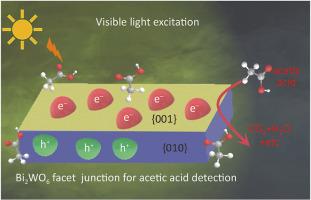Enhanced spatial charge separation and gas adsorption in Bi2WO6 facet junction for efficient visible light-excited gas detection at room temperature
IF 9.6
1区 材料科学
Q1 CHEMISTRY, PHYSICAL
引用次数: 0
Abstract
Enhancing the room temperature gas sensing capabilities of semiconductor sensors through light excitation has emerged as a prominent research focus in recent years. However, challenges such as the high photo-generated charges recombination rate and poor visible light absorption of representative semiconductor gas sensing materials have posed significant issues. To address these challenges, Aurivillius type Bi2WO6 with exceptional visible light absorption was chosen as the model material to explore facet junctions in semiconductor gas sensors for the first time. The experiment successfully achieved the self-construction of facet junctions in Bi2WO6 single crystal microplates, exposing both {001} and {010} facets. It was observed that the facet junction, with an optimal facets proportion, not only controlled gas adsorption but also facilitated the efficient separation of photo-generated charges across the anisotropic facets through surface band bending and internal fields, thus enabling the efficient detection of acetic acid under visible light LED excitation at room temperature. Through first-principle calculations, in-situ infrared spectroscopy and other spectroscopic techniques, the gas sensing mechanism was systematically elucidated. This study offers new insights into enhancing the gas sensing performance of light-excited semiconductor gas sensors through facet junction design. Moreover, it significantly enriches our understanding of the microscopic-scale gas sensing mechanisms.


增强Bi2WO6面结的空间电荷分离和气体吸附,用于室温下有效的可见光激发气体检测
利用光激发增强半导体传感器的室温气体传感能力是近年来的研究热点。然而,典型半导体气敏材料的高光生电荷复合率和可见光吸收差等挑战已经提出了重大问题。为了解决这些挑战,Aurivillius型Bi2WO6具有优异的可见光吸收能力,首次被选择作为模型材料来探索半导体气体传感器的面结。实验成功地在Bi2WO6单晶微孔板上实现了面结的自构建,同时暴露了{001}和{010}两个面。结果表明,具有最佳facet比例的facet结不仅控制了气体吸附,而且通过表面带弯曲和内部场促进了光产生电荷在各向异性facet上的有效分离,从而实现了室温下可见光LED激发下醋酸的高效检测。通过第一性原理计算、原位红外光谱等光谱技术,系统地阐明了气敏机理。该研究为通过面结设计提高光激发半导体气体传感器的气敏性能提供了新的见解。此外,它极大地丰富了我们对微观尺度气敏机理的理解。
本文章由计算机程序翻译,如有差异,请以英文原文为准。
求助全文
约1分钟内获得全文
求助全文
来源期刊

Journal of Materiomics
Materials Science-Metals and Alloys
CiteScore
14.30
自引率
6.40%
发文量
331
审稿时长
37 days
期刊介绍:
The Journal of Materiomics is a peer-reviewed open-access journal that aims to serve as a forum for the continuous dissemination of research within the field of materials science. It particularly emphasizes systematic studies on the relationships between composition, processing, structure, property, and performance of advanced materials. The journal is supported by the Chinese Ceramic Society and is indexed in SCIE and Scopus. It is commonly referred to as J Materiomics.
 求助内容:
求助内容: 应助结果提醒方式:
应助结果提醒方式:


